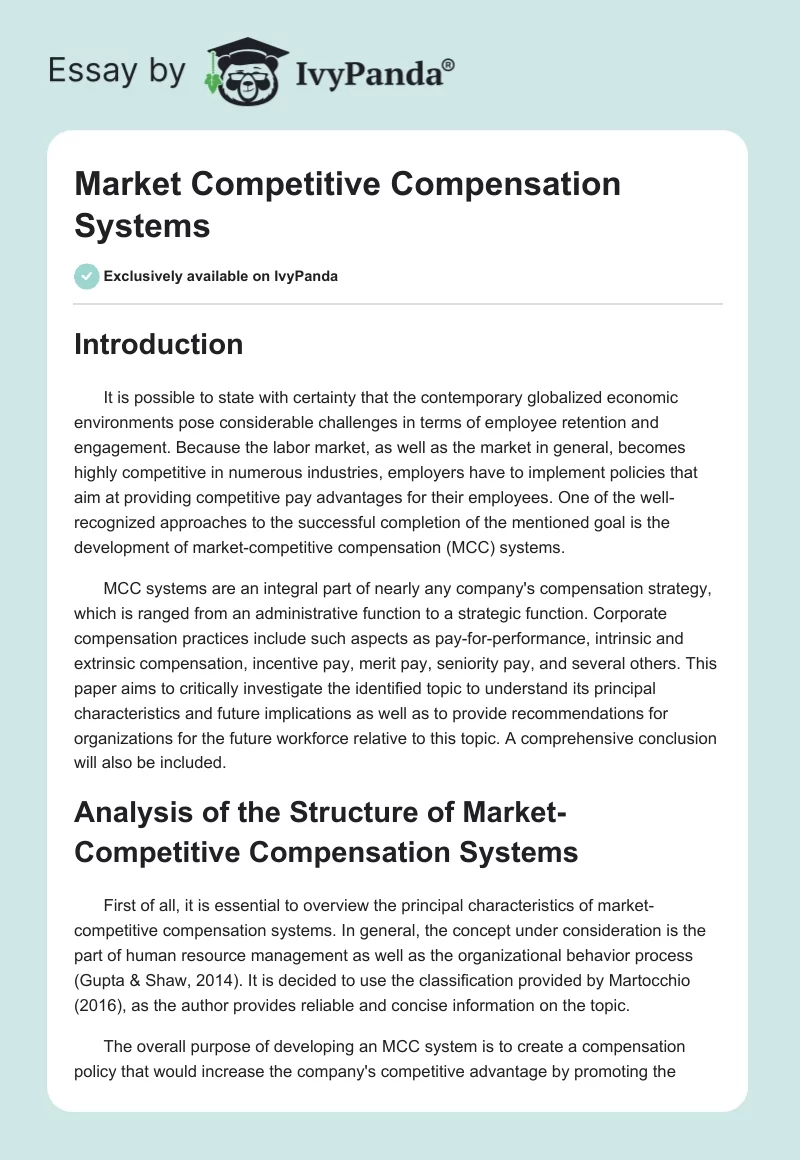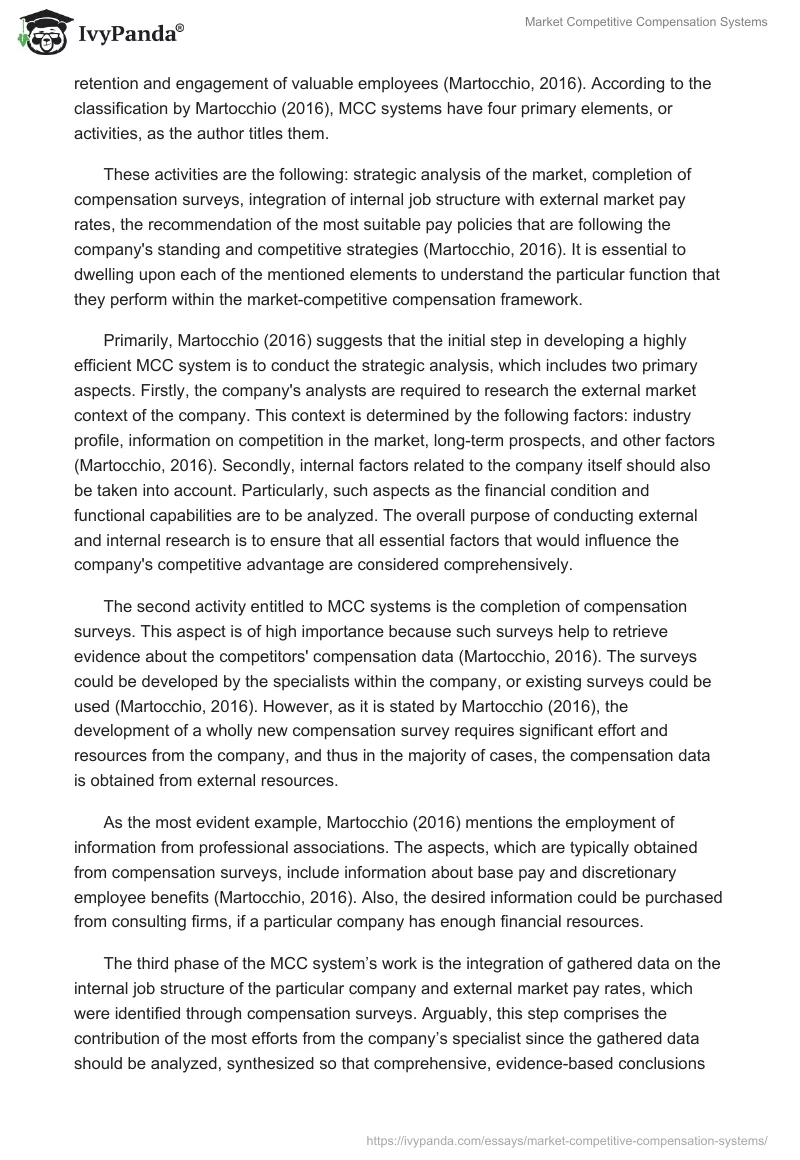- Introduction
- Analysis of the Structure of Market-Competitive Compensation Systems
- Application of Concepts and Research to Student and Employer Experience
- Future Implications of the Topic Under Consideration
- Recommendations for Organization for the Improvement of Compensation Policies
- Conclusion
- References
Introduction
It is possible to state with certainty that the contemporary globalized economic environments pose considerable challenges in terms of employee retention and engagement. Because the labor market, as well as the market in general, becomes highly competitive in numerous industries, employers have to implement policies that aim at providing competitive pay advantages for their employees. One of the well-recognized approaches to the successful completion of the mentioned goal is the development of market-competitive compensation (MCC) systems.
MCC systems are an integral part of nearly any company’s compensation strategy, which is ranged from an administrative function to a strategic function. Corporate compensation practices include such aspects as pay-for-performance, intrinsic and extrinsic compensation, incentive pay, merit pay, seniority pay, and several others. This paper aims to critically investigate the identified topic to understand its principal characteristics and future implications as well as to provide recommendations for organizations for the future workforce relative to this topic. A comprehensive conclusion will also be included.
Analysis of the Structure of Market-Competitive Compensation Systems
First of all, it is essential to overview the principal characteristics of market-competitive compensation systems. In general, the concept under consideration is the part of human resource management as well as the organizational behavior process (Gupta & Shaw, 2014). It is decided to use the classification provided by Martocchio (2016), as the author provides reliable and concise information on the topic.
The overall purpose of developing an MCC system is to create a compensation policy that would increase the company’s competitive advantage by promoting the retention and engagement of valuable employees (Martocchio, 2016). According to the classification by Martocchio (2016), MCC systems have four primary elements, or activities, as the author titles them.
These activities are the following: strategic analysis of the market, completion of compensation surveys, integration of internal job structure with external market pay rates, the recommendation of the most suitable pay policies that are following the company’s standing and competitive strategies (Martocchio, 2016). It is essential to dwelling upon each of the mentioned elements to understand the particular function that they perform within the market-competitive compensation framework.
Primarily, Martocchio (2016) suggests that the initial step in developing a highly efficient MCC system is to conduct the strategic analysis, which includes two primary aspects. Firstly, the company’s analysts are required to research the external market context of the company. This context is determined by the following factors: industry profile, information on competition in the market, long-term prospects, and other factors (Martocchio, 2016). Secondly, internal factors related to the company itself should also be taken into account. Particularly, such aspects as the financial condition and functional capabilities are to be analyzed. The overall purpose of conducting external and internal research is to ensure that all essential factors that would influence the company’s competitive advantage are considered comprehensively.
The second activity entitled to MCC systems is the completion of compensation surveys. This aspect is of high importance because such surveys help to retrieve evidence about the competitors’ compensation data (Martocchio, 2016). The surveys could be developed by the specialists within the company, or existing surveys could be used (Martocchio, 2016). However, as it is stated by Martocchio (2016), the development of a wholly new compensation survey requires significant effort and resources from the company, and thus in the majority of cases, the compensation data is obtained from external resources.
As the most evident example, Martocchio (2016) mentions the employment of information from professional associations. The aspects, which are typically obtained from compensation surveys, include information about base pay and discretionary employee benefits (Martocchio, 2016). Also, the desired information could be purchased from consulting firms, if a particular company has enough financial resources.
The third phase of the MCC system’s work is the integration of gathered data on the internal job structure of the particular company and external market pay rates, which were identified through compensation surveys. Arguably, this step comprises the contribution of the most efforts from the company’s specialist since the gathered data should be analyzed, synthesized so that comprehensive, evidence-based conclusions and recommendations could be retrieved from it. According to the research by McCormick (2016), among various approaches to efficient increasing of the compensation pay rate, the pay-for-performance compensation appears to be the most efficient. In general, the process of integration is based on the analysis of the gathered data, which includes the comparison of benchmark jobs (which reflect the average pay rate for a typical job position in the industry) with the matching job positions in competitive companies.
Accordingly, the overall purpose of this activity is to set pay rates within the company so that they matched the company’s internal job structure and external market pay rates. Thus, the process of developing these pay policies constitute the fourth activity of the MCC system’s functioning. As it is mentioned by Morris, Alvarez, Barney, and Molloy (2017), the development of compensation pay rates is used by the companies in the majority of cases to make firm-specific human capital investments.
Thus, a company ensures gains a competitive advantage; however, the cost of incentives should be less than the value the firm-specific investments create (Morris et al., 2017). Additionally, the study by Aguenza and Som (2018) states that such factors as career development, job characteristics, recognition, and work/life balance should also be considered as part of strategic compensation within the company.
Application of Concepts and Research to Student and Employer Experience
Considering the application of the overall topic of this paper to student and employer experience, it is possible to mention that for me as a student the studying of the MCC system has largely improved my knowledge on the topic of strategic compensation. Also, I could reference the experience from my employment at a company several years ago. It should be stated that from the current perspective of my knowledge on the topic, I can suggest that the market-competitive compensation system was not developed in that company to a sufficient extent. The system of bonuses and motivators existed but is primarily employed the pay-for-time approach, which was not very motivating for me.
Future Implications of the Topic Under Consideration
It is evident that the contemporary market is highly competitive, and the ongoing process of globalization continues to shape the conditions in the international market as well as in local markets. According to Morris et al. (2017), the investment in the firm-specific human capital in the form of developing a comprehensive MCC system should be paid considerable attention by middle and top managers in industries where competition is significantly high.
Also, as Aguenza and Som (2018) suggest, the retention and engagement should be taken into account as the high priorities for any organization since in highly competitive markets, it is of great importance to retaining the most efficient employees since it is more productive than hiring and training new workers.
Recommendations for Organization for the Improvement of Compensation Policies
The recommendations for organizations derive from the previously conducted analysis and discussion of market-competitive compensation systems. For example, as it was already mentioned, Morris et al. (2017) suggest that pay-for-performance compensation is a highly beneficial approach for increasing the competitive advantage of the organization. It is also recommended that companies should perform extensive market research that captures the most recent data on the state of the market.
Aguenza and Som (2018) consider career development and work/life balance to be highly important aspects of increasing the competitive advantage of the firm. Overall, the employment of the most recent and comprehensive data on the labor market as well as implementing internal instruments of motivation would significantly improve compensation policies in the majority of organizations.
Conclusion
Market-competitive compensation systems are highly complex, yet significantly effective instruments of gaining a competitive advantage in markets and industries with developed rivalry. This paper conducted comprehensive research on the principal elements of any MCC system. It is found out that strategic market analysis, identification of internal job structure and external competitive factors, and synthesis of compensation policy recommendations based on the gathered information are critical stages of creating an efficient compensation rate for the employees of the particular company. Additionally, the paper provides examples from experience, as well as future implications and recommendations for organizations in terms of developing and gaining competitive advantage, was discussed.
References
Aguenza, B. B., & Som, A. P. M. (2018). Motivational factors of employee retention and engagement in organizations. International Journal of Advances in Management and Economics, 1(6), 88-95.
Gupta, N., & Shaw, J. D. (2014). Employee compensation: The neglected area of HRM research. Human Resource Management Review, 24(1), 1-4.
Martocchio, J. J. (2016). Strategic compensation: A human resource management approach (9th ed.). Pearson.
McCormick, C. S. (2016). Examining the impact of pay-for-time and pay-for-performance compensation on measures of productivity. Web.
Morris, S. S., Alvarez, S. A., Barney, J. B., & Molloy, J. C. (2017). Firm-specific human capital investments as a signal of general value: Revisiting assumptions about human capital and how it is managed. Strategic Management Journal, 38(4), 912-919.


